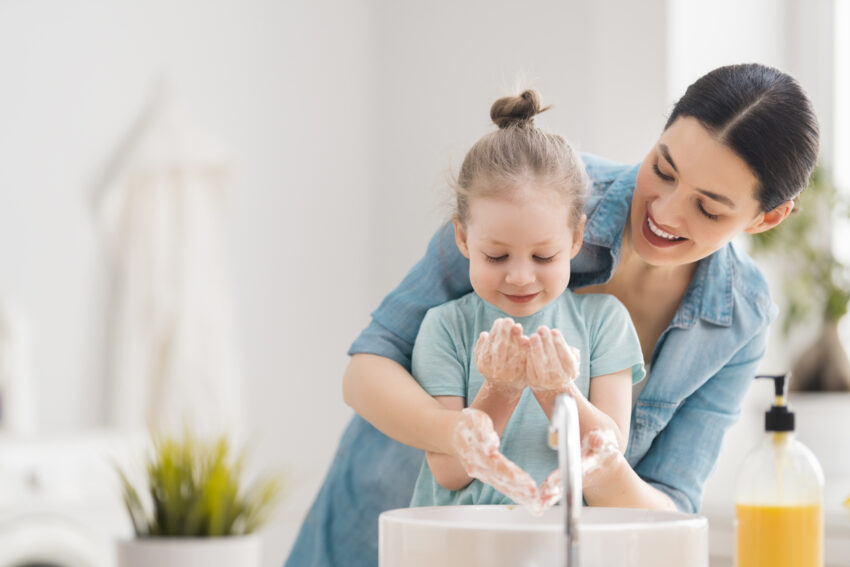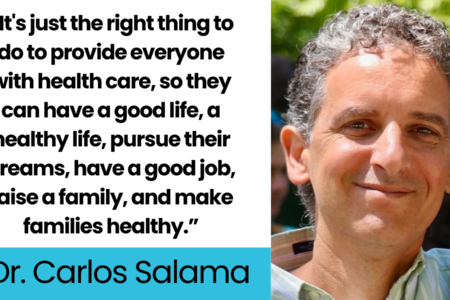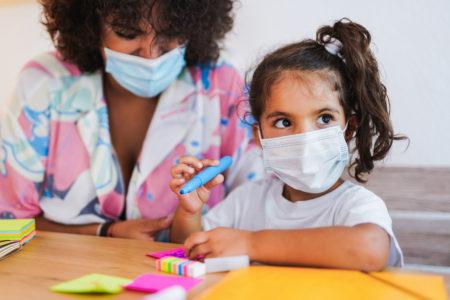
Share On Social!
Teachers and administrators play a large role in keeping kids clean and healthy at school.
However, it’s also up to caregivers to teach healthy hygiene habits at home.
That’s why the U.S. Centers for Disease Control and Prevention (CDC) and the CDC Foundation created the Clean Hands and Spaces online bilingual training (in English and in Spanish) for teachers, administrators, and staff in schools and Head Start centers.
Learn how teachers can work together with caregivers to keep kids clean and healthy.
What Is the Clean Hands and Spaces Training?
Clean Hands and Spaces is an online bilingual training that aims to help K-12 school and early childhood education (ECE) staff learn how to best encourage good hygiene practices in their educational settings.
The training consists of four modules on:
- How and when to clean hands
- How to create a hygiene plan in an educational environment
- How to select, use, and safely store cleaners and disinfectants
- How to team up with parents and caregivers to build good habits with children
You’ll learn from experts in the field about how to protect your educational community by promoting good hygiene practices. You can complete the training anytime at your own pace, and continuing education credits are available in English.
This training will help you and your school community or Head Start center get the knowledge and skills needed to encourage good hygiene practices and stop illness from spreading.
GET THE CLEAN HANDS & SPACES BILINGUAL TRAINING IN ENGLISH AND IN SPANISH!
What Does the “Helping Schools and Parents Build Good Hygiene Habits with Children” Module Cover?
The final module of the “Clean Hands and Spaces” training covers how school administrators can teach caregivers about good hygiene habits.
“Parents and caregivers at home can help too. They help keep children healthy by supporting hand hygiene. They also help by doing regular cleaning and disinfecting,” according to the module.
The training goes over how administrators can:
- Share the knowledge with caregivers
- Keep in touch with caregivers
It’s important to teach caregivers how to practice good hygiene with kids because it continues practicing what they learn in school.
“Children need consistent messaging from adults. It helps kids build good habits. Learning hand hygiene early helps it become a lifelong healthy habit,” according to the module.
 The training emphasizes using concise and easy-to-understand materials when communicating with caregivers, noting potential language differences.
The training emphasizes using concise and easy-to-understand materials when communicating with caregivers, noting potential language differences.
“Remember, not everyone uses English to communicate at home. Keep this in mind as you develop strategies for communication and pick materials to send home. CDC has hand hygiene materials available in several languages on their website,” according to the module.
Caregivers are often busy and juggling many responsibilities.
The training recommends bearing this in mind when choosing how often to communicate about hygiene.
“Time is valuable. Don’t communicate too often. Avoid giving too much info. They may stop paying attention. Send it on key school calendar dates,” according to the module.
GET THE CLEAN HANDS & SPACES BILINGUAL TRAINING IN ENGLISH AND IN SPANISH!
How Does Good Hand Hygiene Help Hispanics/Latinos?
Hispanic/Latino students account for 27% of students enrolled in public schools.
Hand hygiene is especially important among this population, which faces a heavy burden of illness and health disparities due to systemic and structural inequities in the areas of income, lack of access to healthcare, healthcare system equity (which includes infection control), healthy food, quality housing and green spaces.
Frequently missing school can have a long-term impact on academic success.
“Every child should be able to learn the importance of hygiene and use best practices to keep themselves, caregivers, and parents safe,” said Dr. Amelie G. Ramirez, director of Salud America! at UT Health San Antonio.
GET THE CLEAN HANDS & SPACES BILINGUAL TRAINING IN ENGLISH AND IN SPANISH!
Explore More:
Infection ControlBy The Numbers
142
Percent
Expected rise in Latino cancer cases in coming years




[…] The pandemic is another chapter in the bitter story of American racism and inequality. Black and Latinx people are being infected and are dying at much higher rates than white Americans. Many people of […]
[…] coronavirus has killed over 61,000 Latinos in America according to the CDC, accounting for over 18.2% of the total COVID deaths in the […]
[…] Whereas Hispanics make up 11% of D.C.’s inhabitants, they signify 19% of the COVID cases, and 14% of the deaths. Equally, 46% of D.C.’s residents are Black, they usually make up an alarming 75% […]
[…] and historical mistreatment. According to the U.S. Centers for Disease Control and Prevention, Latino and Black American communities are three times more likely to become infected with […]
[…] Covid pandemic has hit the Latino community particularly hard, and data from the nonprofit health equity advocacy group Salud America! shows Latinos lead in the 0-24 age […]
[…] the pandemic, Latinos took major blows, both in terms of COVID-19 cases and also from the economic recession under former President Donald Trump. Nearly half (49%) of […]
[…] the positive trend, the harm may have already been done. The pandemic has disproportionately impacted Latino communities. Reuters reported that election-related or political disinformation that […]
[…] pesar de la tendencia positiva, es posible que el daño ya esté hecho. La pandemia ha impactado desproporcionadamente Comunidades latinas. Reuters informó que la desinformación política o relacionada con las […]
[…] residentes blancos muestran una tasa mucho más baja con 10 muertes por cada 100,000 habitantes(8 9) . Los afroestadounidenses por su parte, denuncian subsistemas de salud que les segregan […]
[…] https://salud-america.org/coronavirus-case-rates-and-death-rates-for-latinos-in-the-united-states/ […]
[…] https://salud-america.org/coronavirus-case-rates-and-death-rates-for-latinos-in-the-united-states/ […]
[…] communities have the second-highest number of COVID-19 cases in the U.S. They’re also more likely to become hospitalized and die from the disease than other […]
[…] total, around 160,000 Latinos were killed by COVID-19. This accounts for 16% of the 1 million deaths in the country. The […]